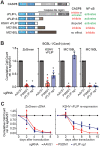CRISPR screens identify novel regulators of cFLIP dependency and ligand-independent, TRAIL-R1-mediated cell death
- PMID: 36801923
- PMCID: PMC10154404
- DOI: 10.1038/s41418-023-01133-0
CRISPR screens identify novel regulators of cFLIP dependency and ligand-independent, TRAIL-R1-mediated cell death
Abstract
Kaposi's sarcoma-associated herpesvirus (KSHV) causes primary effusion lymphoma (PEL). PEL cell lines require expression of the cellular FLICE inhibitory protein (cFLIP) for survival, although KSHV encodes a viral homolog of this protein (vFLIP). Cellular and viral FLIP proteins have several functions, including, most importantly, the inhibition of pro-apoptotic caspase 8 and modulation of NF-κB signaling. To investigate the essential role of cFLIP and its potential redundancy with vFLIP in PEL cells, we first performed rescue experiments with human or viral FLIP proteins known to affect FLIP target pathways differently. The long and short isoforms of cFLIP and molluscum contagiosum virus MC159L, which are all strong caspase 8 inhibitors, efficiently rescued the loss of endogenous cFLIP activity in PEL cells. KSHV vFLIP was unable to fully rescue the loss of endogenous cFLIP and is therefore functionally distinct. Next, we employed genome-wide CRISPR/Cas9 synthetic rescue screens to identify loss of function perturbations that can compensate for cFLIP knockout. Results from these screens and our validation experiments implicate the canonical cFLIP target caspase 8 and TRAIL receptor 1 (TRAIL-R1 or TNFRSF10A) in promoting constitutive death signaling in PEL cells. However, this process was independent of TRAIL receptor 2 or TRAIL, the latter of which is not detectable in PEL cell cultures. The requirement for cFLIP is also overcome by inactivation of the ER/Golgi resident chondroitin sulfate proteoglycan synthesis and UFMylation pathways, Jagunal homolog 1 (JAGN1) or CXCR4. UFMylation and JAGN1, but not chondroitin sulfate proteoglycan synthesis or CXCR4, contribute to TRAIL-R1 expression. In sum, our work shows that cFLIP is required in PEL cells to inhibit ligand-independent TRAIL-R1 cell death signaling downstream of a complex set of ER/Golgi-associated processes that have not previously been implicated in cFLIP or TRAIL-R1 function.
© 2023. The Author(s), under exclusive licence to ADMC Associazione Differenziamento e Morte Cellulare.
Conflict of interest statement
The authors declare no competing interests.
Figures






Similar articles
-
Cellular FLICE-inhibitory protein (cFLIP) isoforms block CD95- and TRAIL death receptor-induced gene induction irrespective of processing of caspase-8 or cFLIP in the death-inducing signaling complex.J Biol Chem. 2011 May 13;286(19):16631-46. doi: 10.1074/jbc.M110.148585. Epub 2011 Mar 22. J Biol Chem. 2011. PMID: 21454681 Free PMC article.
-
Viral FLIP blocks Caspase-8 driven apoptosis in the gut in vivo.PLoS One. 2020 Jan 30;15(1):e0228441. doi: 10.1371/journal.pone.0228441. eCollection 2020. PLoS One. 2020. PMID: 31999759 Free PMC article.
-
Suppression of cFLIP is sufficient to sensitize human melanoma cells to TRAIL- and CD95L-mediated apoptosis.Oncogene. 2008 May 15;27(22):3211-20. doi: 10.1038/sj.onc.1210985. Epub 2007 Dec 17. Oncogene. 2008. PMID: 18084329
-
Down-regulation of intracellular anti-apoptotic proteins, particularly c-FLIP by therapeutic agents; the novel view to overcome resistance to TRAIL.J Cell Physiol. 2018 Oct;233(10):6470-6485. doi: 10.1002/jcp.26585. Epub 2018 May 9. J Cell Physiol. 2018. PMID: 29741767 Review.
-
Cyclooxygenase-2-prostaglandin E2-eicosanoid receptor inflammatory axis: a key player in Kaposi's sarcoma-associated herpes virus associated malignancies.Transl Res. 2013 Aug;162(2):77-92. doi: 10.1016/j.trsl.2013.03.004. Epub 2013 Apr 6. Transl Res. 2013. PMID: 23567332 Free PMC article. Review.
Cited by
-
Let's make it personal: CRISPR tools in manipulating cell death pathways for cancer treatment.Cell Biol Toxicol. 2024 Jul 29;40(1):61. doi: 10.1007/s10565-024-09907-z. Cell Biol Toxicol. 2024. PMID: 39075259 Free PMC article. Review.
-
Biological Functions and Clinical Implications of CFLAR: From Cell Death Mechanisms to Therapeutic Targeting in Immune Regulation.J Inflamm Res. 2025 Apr 9;18:4911-4928. doi: 10.2147/JIR.S519885. eCollection 2025. J Inflamm Res. 2025. PMID: 40224389 Free PMC article. Review.
-
A JAGN1-associated severe congenital neutropenia zebrafish model revealed an altered G-CSFR signaling and UPR activation.Blood Adv. 2024 Aug 13;8(15):4050-4065. doi: 10.1182/bloodadvances.2023011656. Blood Adv. 2024. PMID: 38739706 Free PMC article.
-
Basic and applied research progress of TRAIL in hematologic malignancies.Blood Sci. 2025 Mar 11;7(2):e00221. doi: 10.1097/BS9.0000000000000221. eCollection 2025 Jun. Blood Sci. 2025. PMID: 40084090 Free PMC article. Review.
-
Cytotoxicity of Activator Expression in CRISPR-based Transcriptional Activation Systems.bioRxiv [Preprint]. 2024 Sep 23:2024.09.23.614524. doi: 10.1101/2024.09.23.614524. bioRxiv. 2024. PMID: 39386518 Free PMC article. Preprint.
References
Publication types
MeSH terms
Substances
Grants and funding
LinkOut - more resources
Full Text Sources
Research Materials

